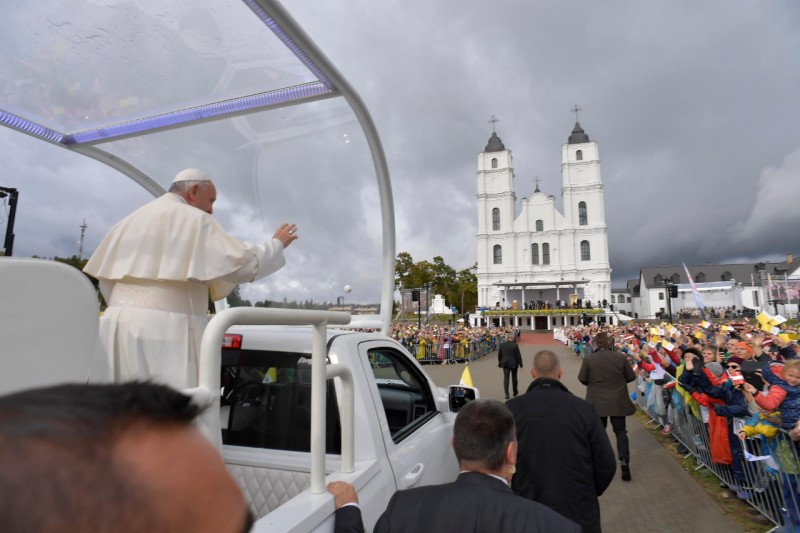When we face life’s great challenges, Mary stands beside us. That was the essence of the message Pope Francis delivered in his September 24, 2018, homily at the Shrine of the Mother of God in Aglona, Latvia.
“Truly, we can say that what Saint Luke tells us at the beginning of the book of the Acts of the Apostles is being repeated here today: we are joined together in prayer, in the company of Mary our Mother (cf. Acts 1:14),” Pope Francis proclaimed. “Today we make our own the theme of this Visit: ‘Show yourself as Mother!’ Show us, Mother, where you continue to sing your Magnificat. Show us the places where your Son is crucified, that we may encounter your steady presence at the foot of the cross.’
The Holy Father pointed out that the Gospel of John speaks of only two times in the life of Jesus where the Lord and his mother interacted. The first was the wedding feast at Cana, where she told him to make more wine for the guests. The second was at the cross.
 “Perhaps the Evangelist wants to show us the Mother of Jesus in these two apparently opposite situations in life – the joy of a wedding feast and sorrow at the death of a child,” Francis explained. “In her growing understanding of the mystery of the Word, Mary points us to the Good News that the Lord wants to share with us today.
“Perhaps the Evangelist wants to show us the Mother of Jesus in these two apparently opposite situations in life – the joy of a wedding feast and sorrow at the death of a child,” Francis explained. “In her growing understanding of the mystery of the Word, Mary points us to the Good News that the Lord wants to share with us today.
“The first thing John mentions is that Mary “stands near the cross of Jesus”, close to her Son. She stood there, at the foot of the cross, with unwavering conviction, fearless and immovable. This is the main way that Mary shows herself – she stands near those who suffer, those from whom the world flees, including those who have been put on trial, condemned by all, deported.”
The Holy Father explained that Mary not only is present to offer us comfort but through her example shows us how to offer comfort to others. He suggests that we, too, are called to reach out to those who are suffering and to accompany them.
“Like Mary, let us remain steadfast, our hearts at peace in God. Let us be ever ready to lift up the fallen, raise up the lowly and to help end all those situations of oppression that make people feel crucified themselves,” Francis said. “Let us not be afraid to experience the power of tenderness, to get involved and let our lives become complicated for the sake of others.”
 The Pope went on to explain that Jesus asked those closest to him to not just be together but to “receive” one another. He asks Mary to “receive” John as her sone – and John to “receive” Mary as his mother.
The Pope went on to explain that Jesus asked those closest to him to not just be together but to “receive” one another. He asks Mary to “receive” John as her sone – and John to “receive” Mary as his mother.
“For we can stand at the side of many people, even sharing the same home, neighborhood or workplace; we can share the faith, contemplate and experience the same mysteries, but without embracing or actually ‘receiving’ them with love.,” Francis stressed. “How many married couples could speak of lives lived next to one another, but not together; how many young people feel pained by the distance separating them from adults; how many elderly people feel tolerated, but not lovingly cared for and accepted.
“Mary wants to give us her courage so that we too can remain steadfast, and her humility, so that, like her, we can adapt to whatever life brings.”
Aglona Basilica is the major Roman Catholic shrine of Latvia. Pilgrims flock to the site on August 15 each year to celebrate the Assumption of the Blessed Virgin Mary into Heaven. In 1980, the Church celebrated its 200th anniversary and was officially given the status of a minor basilica by Pope John Paul II. In 1986, it was the site of the celebration of the 800th anniversary of Christianity in Latvia. In September 1993, Pope John Paul II visited the Shrine, joined by a crowd of some 300,000 pilgrims.

© Vatican Media
Latvia: Today we Make our own the Theme of this Visit: ‘Show Yourself as Mother!’
Holy Father Celebrates Mass at Shrine of the Mother of God, Aglona


